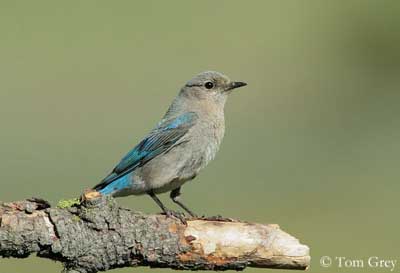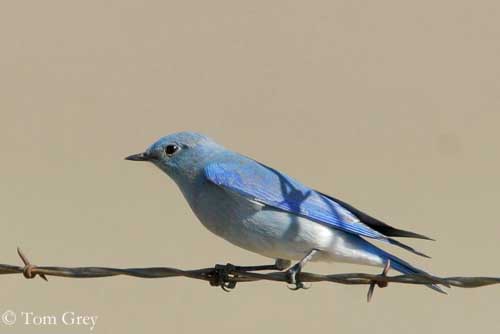
Fr: Merlebleu azure
All : Berghüttensänger
Esp : Azulillo Pálido
Ital: Uccello azzurro di montagna
Nd: Berg-bluebird
Sd: Bergsialia
Photographer:
Tom Grey
Tom Grey's Bird Pictures
Text by Nicole Bouglouan
Sources:
HANDBOOK OF THE BIRDS OF THE WORLD Vol 10 by Josep del Hoyo-Andrew Elliott-David Christie - Lynx Edicions - ISBN: 8487334725
A GUIDE TO THE BIRDS OF MEXICO AND NORTHERN CENTRAL AMERICA by Steve N. G. Howell, Sophie Webb - Oxford University Press - ISBN: 0198540124
BIRDS OF THE GREAT BASIN – by Fred A. Ryser - Univ of Nevada Pr -ISBN: 0874170796
FIELD GUIDE TO THE BIRDS OF NORTH AMERICA - National Geographic Society - ISBN: 0792274512
All About Birds (Cornell Lab of Ornithology)
BirdLife International (BirdLife International)
Bird Houses 101 - North American Bird Species that Nest In Birdhouses
Bird Web (Seattle Audubon Society)
What Bird-The ultimate Bird Guide (Mitchell Waite)
Wikipedia, the free encyclopaedia
Mountain Bluebird
Sialia currucoides
Passeriforme Order – Turdidae Family
BIOMETRICS:
Length: 17-20 cm
Weight: 27-33 g
DESCRIPTION:
The Mountain Bluebird is the third bluebird found in North America. The two other species, the Eastern Bluebird and the Western Bluebird, have brighter plumage.
The adult male has bright cobalt-blue upperparts and head, with darker lores and ear-coverts. Flight feathers’ tips and tail’s tips are dark grey.
The underparts are paler, azure-blue. Chin and throat are washed pale turquoise, whereas belly and undertail-coverts are whitish.
The eyes are dark brown. Bill, legs and feet are blackish.

The female is duller. She has warm buff-brownish upperparts with greenish-blue tinge on upperwing, rump and tail. The underparts are pale buff.
Eyes are dark brown with whitish eye-ring. Bill, legs and feet are blackish.
Some females may have pale rufous tinge on the breast.
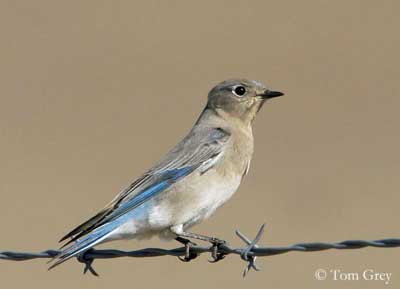
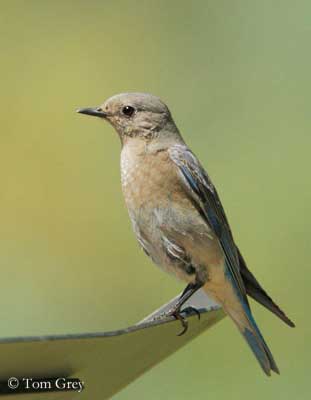
The juvenile is similar to female with slightly darker and duller upperparts, and scaly effect below, especially on throat and breast.
VOICE: SOUNDS BY XENO-CANTO
The Mountain Bluebird utters a thin, nasal “few” or feeer” as contact call. The alarm call is a high-pitched “tink” or a short, harsh “chak”.
The song is given from perches within the territory and near the nest, or sometimes in flight. We can hear two types of songs.
The “day song” is the commoner, a soft, short warbler “eee-ee-e” often repeated.
The “dawn song” is often given in flight, before the first light. This is a loud, warbled “jerrf jerrf jewr jipo jerrf” lasting some seconds. This song is usually heard during the breeding season.
HABITAT:
The Mountain Bluebird breeds in grassland with scattered thickets and shrubs, savannahs, tree-line tundra and prairie-forest and clear-cuts, up to 3800 metres of elevation. It needs cavities for nesting.
It winters in flat grassland with some trees and bushes, also meadows with hedges and trees, lowland, farmland and several types of forests.
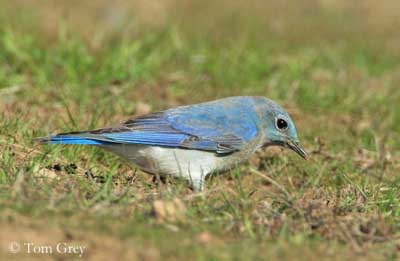
RANGE:
The Mountain Bluebird breeds in C and E Alaska, W and C Canada and W USA.
It winters southwards to SW and SC USA and W and C Mexico.
BEHAVIOUR:
The Mountain Bluebird feeds mainly on insects during the summer, and takes seeds, fruits and berries in autumn and winter.
It forages from perches such as trees, pylons, fences or rocks, or from the ground. Several methods are used. It may perform flycatching, hawking after pursuing an insect in flight, ground-foraging and perch-foraging.
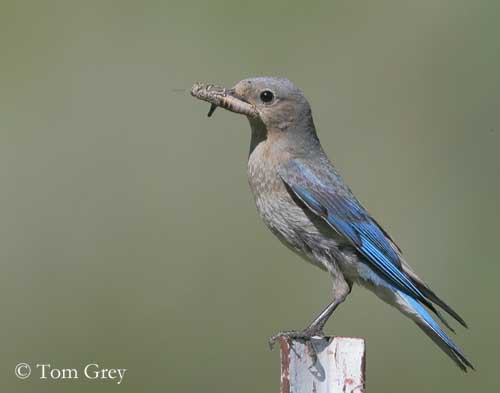
This species usually hunts more from the ground and by hovering than congeners do. It hovers low over grassy grounds in open areas, and drops to pounce on prey.
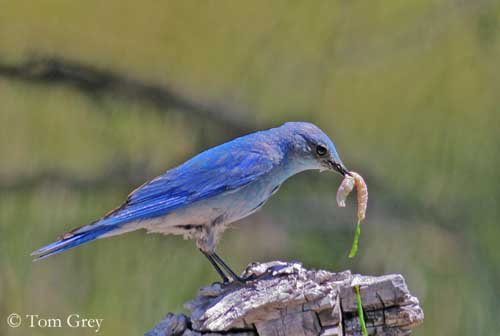
At the beginning of the breeding season, the male arrives first at the breeding grounds. It selects a nest-site, a cavity in tree or rock crevice. The female arrives then, and in order to attract her, the male flies around the nest-site while calling. After the copulation, the female builds the nest. The male guards her from other males.
It is highly territorial. It dives at intruders while performing bill-snapping.
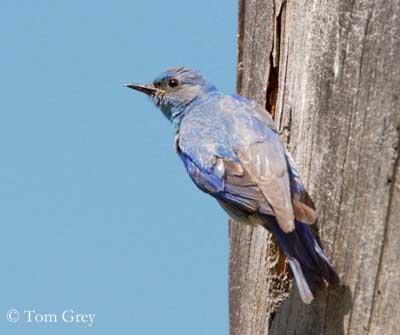
The Mountain Bluebird is migratory in the northern parts of the range, but most of population performs altitudinal movements to winter at lower elevation within the breeding range. But movements are also closely related to fruit availabilities.
They travel in flocks of up to 30 birds, sometimes more. During winter, they can be seen in loose flocks with other passerine species. During the migration, they often stop to feed.
They return to the breeding grounds in March/April, where the males arrive several days or weeks before the females.
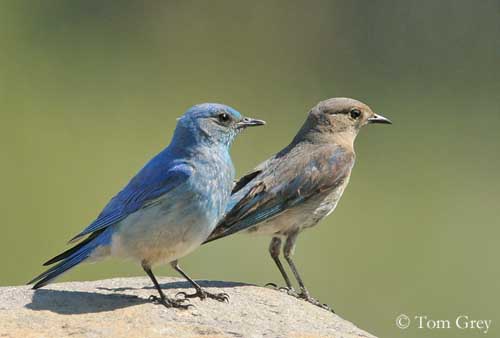
FLIGHT:
The Mountain Bluebird is agile in flight when hunting or migrating. The flight is slow with shallow wing-beats.
It often hovers in the air above the ground in hawk-like manner while searching for preys. When hovering, it performs rapid wing-beats, the tail is spread and feet are dangling.
REPRODUCTION:
The breeding season occurs between April and September. This species usually produces two broods.
The male selects the nest-site and the female builds the nest in cavity, in tree or rock crevice, sometimes helped by the male which brings some materials or guards her.
The nest is a cup made with coarse dry grass, and lined with softer materials such as fine stems, pieces of bark, wool or feathers.
The female lays 4-8 pale blue eggs, and incubates during 13-14 days. The chicks are fed and strongly protected and defended by both adults. They often are very aggressive at this moment.
The young fledge 18-21 days after hatching, and still depend on parents for 3-4 weeks or more, sometimes two months.
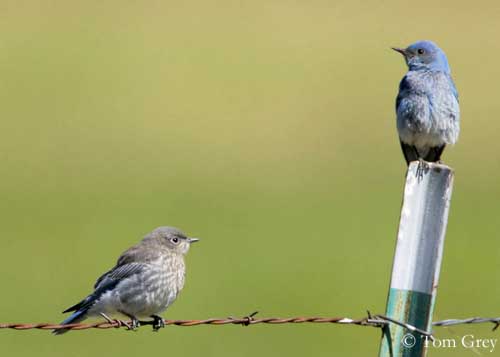
DIET:
The Mountain Bluebird feeds mainly on insects such as Coleoptera, Orthoptera, Hemiptera and several other species in variable amount.
They also consume plant matter such as seeds, fruits and berries from numerous plant species.
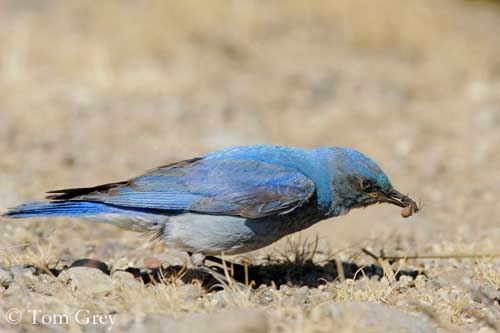
PROTECTION / THREATS / STATUS:
The Mountain Bluebird has stable populations, but low numbers throughout most of the range.
Competition for nesting cavities with the other bluebirds is intense and appears to be an important fact for populations. Nest-boxes availability is a good response to this problem.
This species is not currently threatened and it is evaluated as Least Concern by Birdlife International.
